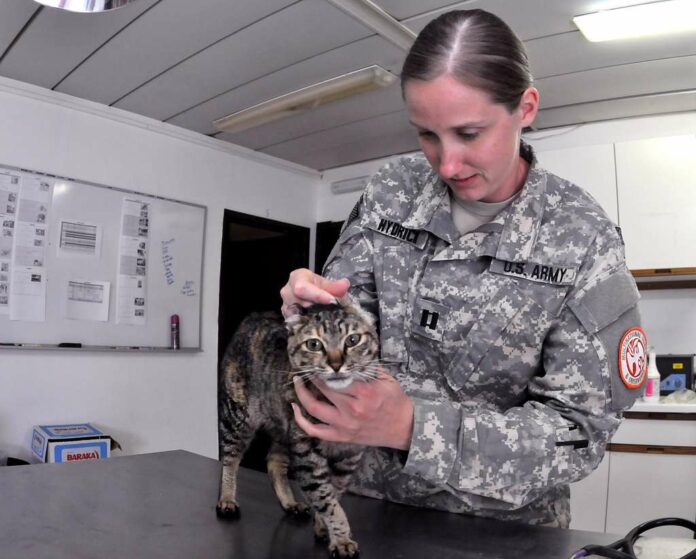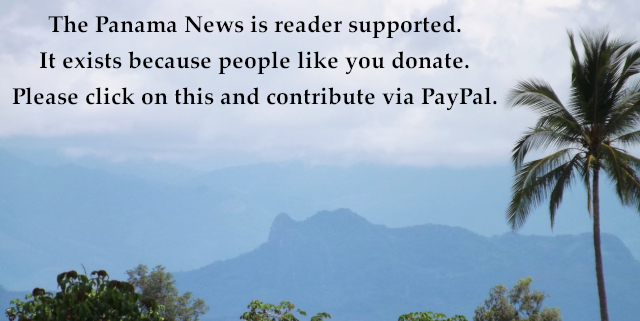US Army Captain Ashley Hydrick, a veterinarian assigned to the Multinational Force and Observers, Sinai, Egypt, provides a routine check up on a cat. US Army photo from 2014.
More international volunteers are coming to Panama
by Eric Jackson
The COVID plague is still with us, and even if we can estimate that the worst of the pestilence is behind us, many consequences linger. The economy has taken a terrible beating. Our public health care system really isn’t up to the task of diagnosing, monitoring and treating long COVID symptoms. And then, there are all the dogs and cats that were abandoned, mainly by folks who could no longer feed them.
Suddenly unemployed middle class Panamanians would take their dogs or cats on a drive into the Interior, and when confident that they were far enough away so that their pets would never return to them, put them out of the car and drive away. Often there were people to take them in, but then for more than a year the spay and neuter groups’ events were shut down, the animals tended to be let out in places where such activities are not held anyway, and a lot of the people who took the animals in are bus riders who just can’t hop in the car with their new charges in search of veterinary care.
The dog and cat populations are exploding and the spay and neuter events are overbooked and overwhelmed. All available additional help is needed. Meanwhile, Migracion reports for this or that sort of mission, more international volunteers are coming to or through Panama lately.
The US Army Veterinarian Corps began in 1916, as US entry into World War I became ever more likely. Its first mission was the inspection of meat animals to be consumed by the troops, to avoid food poisoning and such. Back then they also used mules and horses to haul caissons full of ammunition to combat posts where the roads were not so good. Over the years the US Armed Forces also employed a lot of dogs — as guards, as trackers, as explosives or drug sniffers, in rescuing people buried in battlefield rubble.
In the wake of the world wars, there were US military bases sprinkled around the globe and army vets would care for the pets of military personnel and their dependent families.
This writer’s first contact? At the edges of the hospital grounds of the old Coco Solo Hospital — now the Policlinica Hugo Spadafora — there would from time to time be these horses tied up just outside the jungle. These would be inspected for which insects and arachnids they might get attached to them, and blood samples were taken to see if any such vectors were spreading tropical diseases that could affect humans. People from the US Army Veterinarian Corps did this work.
When the US military bases here were closing ahead of the 1999 deadline, the army’s vet clinic in Corozal was busy getting all stray dogs and cats on the bases neutered and adopted out, so as not to leave problems for Panama. I adopted a kitty there.
So, does “US military intervention” mean that to please right-wing exile groups in Miami, US forces ought to use Howard as a springboard for intervention against fairly elected or otherwise put into power left-wing regimes? Like, for example, that “humanitarian coup” fiasco on the bridge between Colombia and Venezuela a few years back? That we don’t need.
But all along, Panama also gets visited by US Navy hospital ships and other American medical missions, which are both goodwill builders and valuable instruction in diseases that medical personnel would not likely see in the USA. Looking at US Department of Defense media, one will notice that army veterinarians also look after cattle, camels, goats and so on. If the United States is backing a nomadic herding society that’s menaced by jihadis or the like, protection of allies’ herds against natural or induced diseases in part of the defense effort.
The periodic multinational “canal defense” war games take on often fanciful scenarios. The apparent main purposes are the military officer corps of the Americas getting to know one another and “equipment standardization” — multinational arms sales, really. (I don’t think that they have had any maneuvers predicated on little blue Smurf nazis in tiny yellow submarines attacking ships on the approaches to the canal, but you never know.)
But at the moment Panama does face a special situation. A bit of US military assistance for the nation’s spay groups would meet a real and enhanced need at this moment. It would be a much smaller and more fruitful investment than, say, an invasion of Colombia. If the troops go back to the USA having adopted some vicious Panamanian attack cats to bolster US defenses, that would just be gravy.
Contact us by email at fund4thepanamanews@gmail.com
To fend off hackers, organized trolls and other online vandalism, our website comments feature is switched off. Instead, come to our Facebook page to join in the discussion.
These links are interactive — click on the boxes












